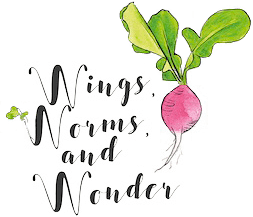Why are My Plant Leaves Yellow? 6 Reasons
Fall color change isn’t the only reason a plant’s leaves turn yellow.
Yellowing can be signs of:
over and under watering,
salt accumulation in potted plants from water,
air pollution,
light or nutrient deficiencies,
and even fungus and disease.
Today we’re going to take a look at reasons why your plant’s leaves may be turning yellow and what you can do about it.
Watering
This one is on you! You have to water your potted and garden plants regularly, both indoors and out. If you don’t, the leaves will yellow. But if you water your plants too much they will also yellow! So how do you know how much to water?
Easy. Feel the soil. If it is dry, water. If it is wet, don’t. You can even buy a simple water meter to gauge this. And make a chart, and put it in a visible area, to track watering schedules and remind you to water. No time to make a chart? I made you one, print it off below!
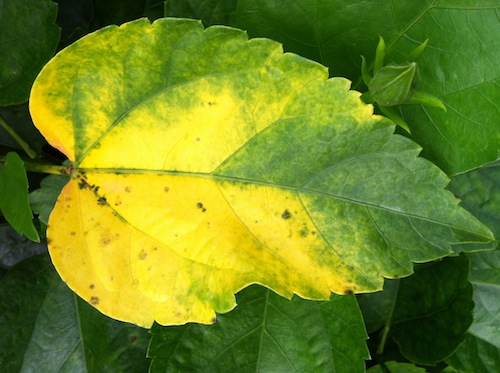
If the plant is in a windy area, under a ceiling fan, or by a vent it will need more water. If it’s pot, or in ground spot, has bad drainage it will need less water.
Sometimes after lots of rain plants will drop some yellow leaves. This is totally normal. They usually recover quickly as things dry out.
Same goes for drought times. Try to water regularly when it doesn’t rain, but don’t be surprised if a plant yellows and drops some leaves while trying to conserve water.
Chlorosis
Chlorosis is the loss of the green color in a plant’s leaves which means the plant isn’t producing chlorophyll through photosynthesis, resulting in the common yellowing of leaves.
Why isn’t the plant photosynthesizing? Because it is deficient in magnesium and iron, which must be available to the plant to make the green chlorophyll. Magnesium is an integral element of chlorophyl and plants also need iron to make the green pigment.
Magnesium deficiency shows up as yellow older leaves, while iron deficiency shows as yellowing of younger leaves.
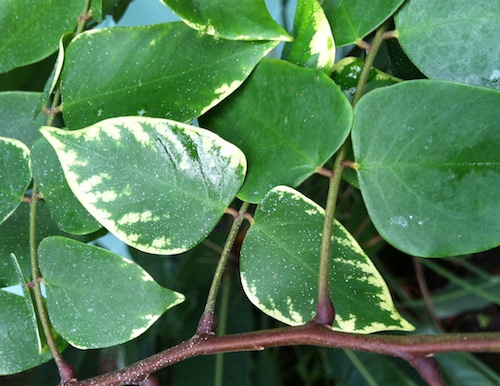
Chlorosis + stunted growth is a sign of a nitrogen deficiency. Nitrogen is a component of chlorophyll too.
What to do? Feed your plants. Since we don’t grow all natives, all plants need to be fed. Get an organic plant food that is targeted at either potted or outdoor in ground plants, depending on what you’re feeding. I generally feed granular food to my outdoor plants (+fish emulsion & compost) and liquid food to indoor plants because it isn’t stinky and is easy to dissolve in my watering can.
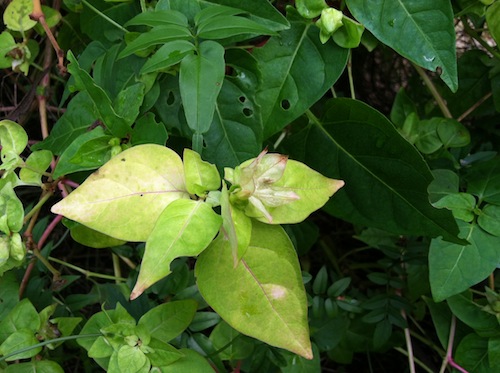
See how the younger leaves are so much more yellow than the older. This = iron deficiency.
Feed plants monthly. You can even add the feeding schedule to your watering chart. I did on the one I made for you. Find the link to print it in the Seeds to Sprout section.
Salts
Have you ever noticed how after a while a white crusts build up on plants’ pots? These are salts from the water. They accumulate over time as the water is used by the plant and the salts are left. These salts are toxic to plants.
If you notice a plant with white crust on it’s pot has started yellowing, repot the plant in fresh new potting soil to try and save it. Some plants are more sensitive to these salts than others.

So crusty!! See the white salts all over the pot, even eating away at both the paint and the terra cotta? There are even salts all over the ground! I have really not been nice to this plant. Time to repot!
Air Pollution
If you live in a polluted area, spray your plants off weekly. Hose and clean the leaves to wash off particles that may clog pores or let toxins in.
The air is really clean where I live so no pics for this one. Sorry about that, but happy for my lungs!
Light
If you have plant that is in a very shady area that is yellowing, get it more light!! BUT do it slowly and first research what type of light your particular plant likes – indirect or direct and how much. This is the 2nd common reason for yellowing, beyond watering, for indoor plants.
Moving a plant that has been in a dark area and suffering immediately into bright direct sun will shock and burn it. You wouldn’t go to the beach for the first time with no sun protection right? Of course not, you’d burn. Same thing with a plants’ leaves. Move it day by day into brighter light first starting with the more gentle morning and late afternoon light.
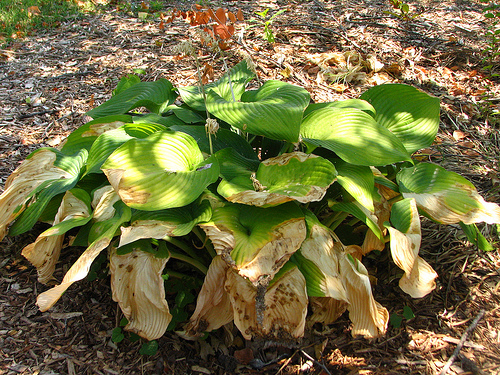
I had to snatch this sunburned plant off the internet. Photo credit
Yellowing can also happen when a shade loving plant gets too much light. Do some research on your plants and put the right plants in the right place – for them. Also, consider how the spot’s light may change over the years when trees grow up or bushes die off or with seasonal sun shifts and leaf drops.
Fungus
This topic is more complex than there is room for in this post, but fungus can be caused by a number of things from both over and under watering to broken spots where plant pathogens have gotten in. Suspect fungus when there are yellow spots on the leaves + other symptoms like wilted looking leaves or brown spots.
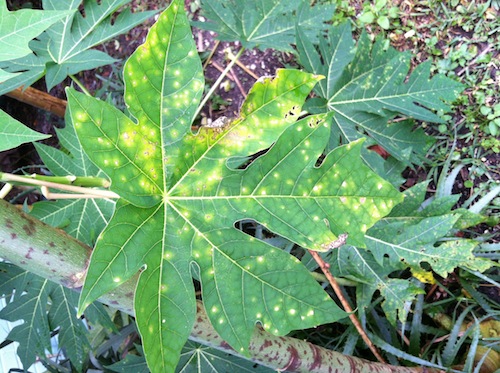
What to do about the actual yellow leaves?
While yellow leaves may be kinda unsightly and make you feel like your green thumb is turing yellow, it is best for the plant to not pick them off for several days.
When a leaf yellows and begins to die, before it drops off, it releases what’s left of the magnesium, nitrogen, and potassium from within the protein and chlorophyll, and transfers it back into the plant’s growing tips.
By leaving the yellow leaves on the plant for a few days, you allow the plant to maximize it’s resources, save, and reuse, all the nutrients it can.
Have any yellow-ish plants? Can you figure out why?
Share in the comments below!
Need help diagnosing?
Share a well lit, in focus pic on Intsagram #wingswormsandwonder and @wingswormsandwonder and I will do my best to help!
Seeds to Sprout:
This is the plant water meter I have. It works well and has lasted me over a decade. I don’t use it too much, but it is nice to use on new plants until I get to know them and their water needs. I get no kickbacks from this company, I just think it’s a good meter.
I made you a watering and feeding chart! Print it off, post it on the fridge, and keep you plants healthily watered and fed! wings worms and wonder watering chart pdf
Get some ideas on different types of organic plant food here. I don’t get any kickbacks from Planet Natural either, but I sure wish I did! Remember, any fish based liquid fertilizer will be stinky and drive your cats bonkers, so don’t use it indoors.
Here’s some info on how and why leaves change color in fall.
